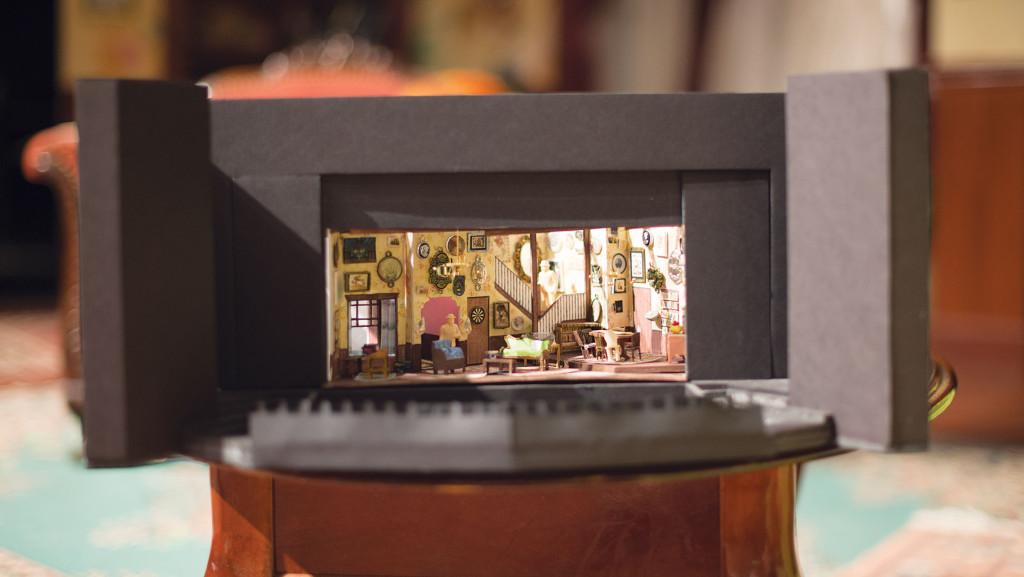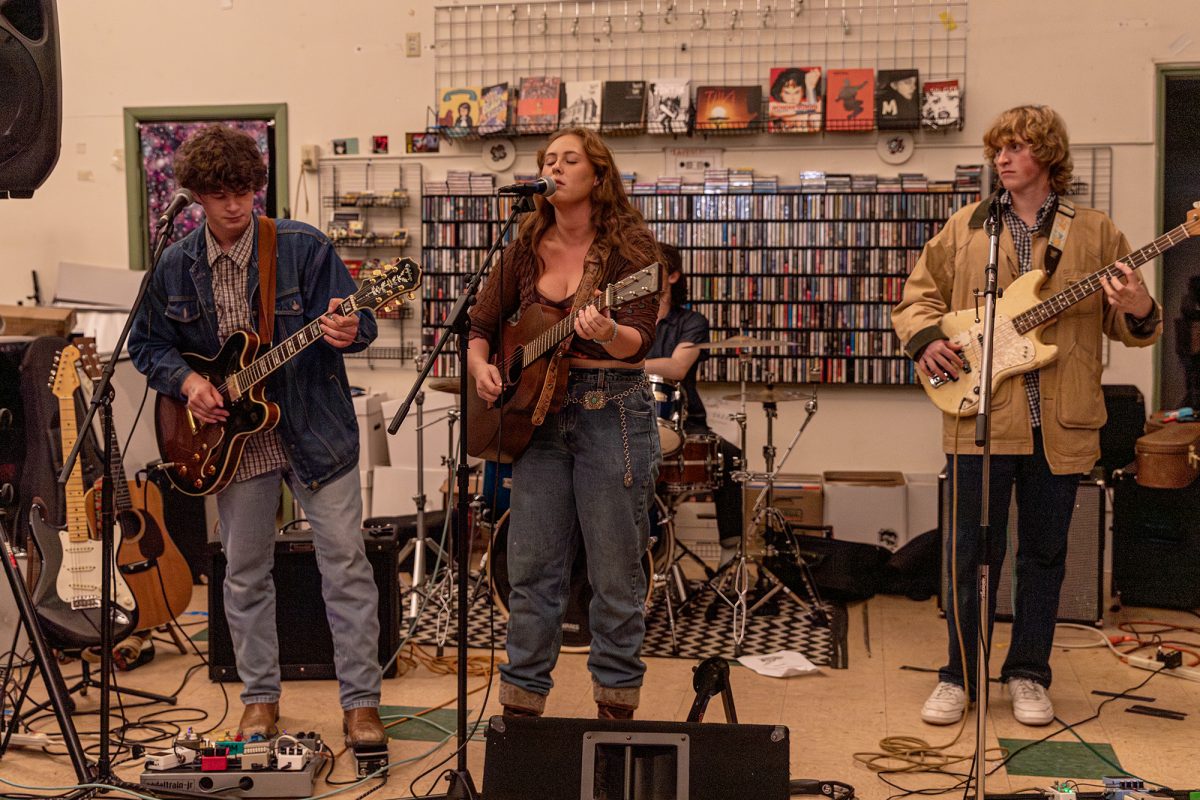Opening Night:
The house is just as eccentric as the family that lives there. Enormous yellow walls, detailed with flowing pink flowers, surround the contents of its quirky living area. They are cluttered with just about anything that can fit on them — paintings, clocks and photographs leave the yellow paint just barely visible.
The wall dressings depict a wide variety of subjects — there’s even one smaller painting of a cat in a bowler hat — that represent the house’s residents: the Sycamore family. The house is almost an additional member to this bizarre group. It is the centerpiece of “You Can’t Take it With You,” Ithaca College’s final Main Stage production of the year, which opened April 16.
The house is designed to accommodate the ebb and flow of the family’s odd interests. The green sofa in the middle of the room is where Grandpa Sycamore will read his newspapers, accompanied by his pet snakes, which reside in a glass tank just behind it. There is plenty of space at the front of the room for the ever-determined Essie to practice her developing ballet routine. The dining room table stage left is where the family will gather for a dinner of Corn Flakes and watermelon. Frequent banging noises and flashes of light escape from the door leading to the basement, where Paul Sycamore and Mr. De Pinna — the ice man who showed up at the Sycamores’ front door years before and never left — tinker with pyrotechnics.
“Each person kind of has one or two set pieces that are very unique to them as characters,” senior Kelly Fairbrother, who plays Penelope Sycamore, the mother of the family, said. “The set is so incredibly detailed that it just helps us, as actors, drop into the time period and the characters.”
For now though, the set is dark, veiled by the massive red curtain that hides it from the audience. Penelope’s typewriter rests, unused for the time being, on her desk stage right. Ed’s xylophone — one of two sound-oriented set pieces — is silent. Over the next two hours, the house will be filled with the noise and laughter and awkward silences of the Sycamore family. But for just a few more moments, it is completely dark, completely silent.
[block] And then, the curtain begins to rise … [/block]
Two weeks earlier:
The Production Conference Room in The Dillingham Center, home to the college’s theater arts department, is a seemingly mundane space. A manilla folder sits on a long, wooden table in the middle of the room, under the harsh, white glow of the fluorescent lighting. Red swivel chairs line the table, and paintings cover the walls. But in this room, the stack of cluttered papers in a manilla folder will soon become a full-fledged theater production.
The folder rests on the table, stuffed to its brim with mismatched papers that spill from its mouth and hang loosely over its tan corners. Its cluttered nature is an anomaly on the otherwise tidy surface.
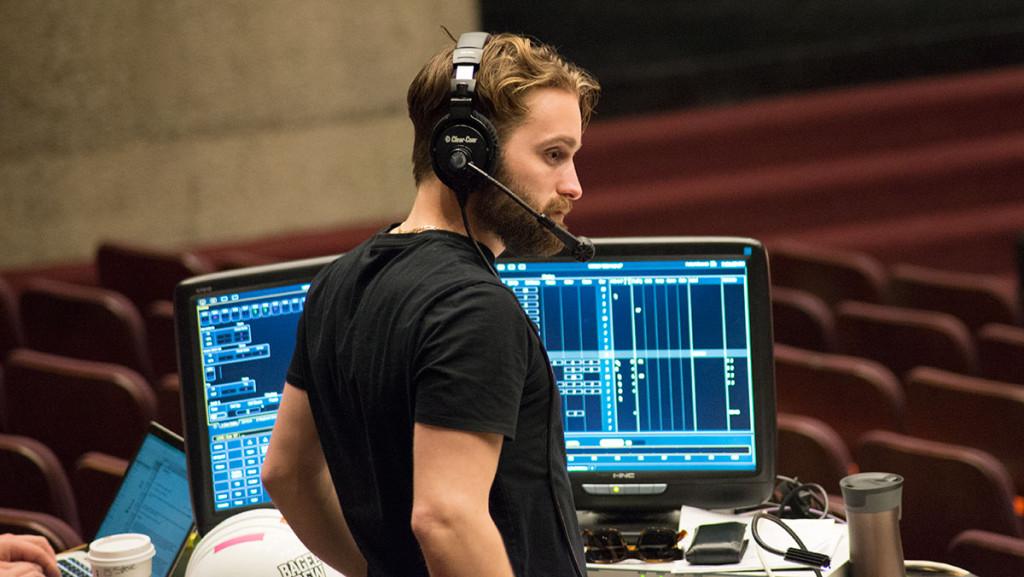
“This is what a show looks like before we put the lights in,” senior Zac Blitz jokes, touching the top of the folder lightly with the tips of his fingers. The lighting designer for the show, Blitz has been responsible for gradually filling the folder with wax paper lighting grid sketches during the months leading up to “You Can’t Take it With You,” which will premiere in two weeks.
For Blitz, the show began as a challenge — a challenge that presented itself in November 2014 in the form of 16-foot high walls that would serve as the perimeter of the set. The walls, along with the long, wooden beams that replicate a high ceiling, test Blitz’s ability to light the stage just the way he wants it, creating blockades for him to rearrange his lighting plan around.
“Considering it’s a comedy, you want a lot of lower angles,” he says. “If you start getting a lot of shadows over people’s eyes, you get this dark, demonic thing.”
To get to a point where Blitz could arrange his lights, the scenic designer, senior Sami Adamson, had to design these walls, which recreate a late-1930s New York City house. But before the Sycamore family can even exist, it is Adamson and Blitz’s job to bring the family’s environment to life.
“It’s like creating your own little world,” Adamson says.
The world Adamson is referring to — that of the Sycamores — is typical of an unconventional family, which follows its bliss, no matter how whimsical and sporadic. It is a set design Adamson is not used to working with, since her previous experience only consists of “Mere Mortals,” which showed in Fall 2013. The Sycamore household, Adamson said, is the polar opposite of the abstract setting she designed for “Mere Mortals.”
“With something like this, at first I thought it was going to be easier than an abstract show because it’s like, ‘Oh, everyone knows what a house looks like,’” she said. “Well, that’s the problem. Because if an audience is sitting there looking at the set and they see something that’s kind of off, it’s going to bother them because they know what a house looks like.”
To portray the nature of the family, Adamson and Blitz need to emphasize the comedic atmosphere and wacky nature of the family.
That’s where the paper sketches and manila folder come in.
Everything in the show that Adamson and Blitz have designed up to this point — months of research, drawing, throwing it all away and drawing again — can be condensed into several complex-looking grids that display lighting designs and floor plans for Adamson’s set.
From her designs, Adamson has produced a hollowed-out black box that is just larger than a shoebox. It’s her own personal mini-stage — almost an exact model of George R. Hoerner Theatre, where the show will be performed — that she uses to model her vision for the set. For now, this box is her visual representation of the scene that she has worked for months to design. Like Blitz’s lighting grids, for the time being, this black box is what Adamson has to show for her months of research and creativity.
She treats it as such, too, carrying it lightly so as not to jostle any of the miniature props, holding it to her chest during transportation. She sets it carefully on the table near Blitz’s lighting grids.
“It’s like creating your own little world” [citation] — Sami Adamson [/citation]
The inside of the box — viewable from the opening in the front as a mimic of an actual stage — looks like a dollhouse, down to the tiny green couch and the scaled-down paintings that clutter the yellow, flowered walls. There’s even a plastic person situated in the middle of the living room area, behind the couches, to simulate an actor.
“This is probably version four or five,” she says. “I started with a white model, what the walls would look like, where the doors would be. Then I did a second white model, and started adding color here and there and then it got to this.”
As complex as the design of the box is, Adamson, as well as the props, carpentry and paint teams, will face an even greater challenge when they begin to make it a reality on the stage. They’ve already run into problems with the walls, which they had to paint by hand, because they couldn’t find a big enough fabric for the massive structures.
At this point, the stage is a huge, black, blank canvas. Adamson’s canvas. Crew members are working on the walls, which lay flat on the stage. Nothing has been constructed. This is not yet a three-dimensional space. But that’s what Adamson’s box is for. She knows what she wants out of the set. And though Blitz is quick to cite the fact that his lighting plans constantly change with the production, he knows what he wants out of the lighting design as well.
The production elements of the play are finally ready to start coming together.
From the Ground up:
One week later, the stage in Hoerner is no longer a blank canvas. With one week until opening night, the Sycamores’ world is coming to life, albeit slowly.
The stage has been transformed. The great, yellow, flowered walls have been erected, a fake wooden floor covers the majority of it. Vintage paintings and photographs — both framed and empty — lie scattered on the floor, some leaning against the staircase at the far corner of the set.
Today, members of the crew are working to hang some of the paintings, which will eventually cover nearly every inch of every wall. But for now, the walls are mostly bare, the pink flowers contrasting against the pale yellow paint. A ladder has been placed near one of the walls, and Adamson is directing the props master, junior Chloe Kirkwood, along with several other crew members, on placement.
“A tad higher … ” Adamson says as Kirkwood, now on top of the ladder, holds a painting against the wall. “No, too high, sorry. A little lower and a little offstage … No, the other offstage. Now it’s tilted. Sorry, can you tilt it back toward you a bit more?”
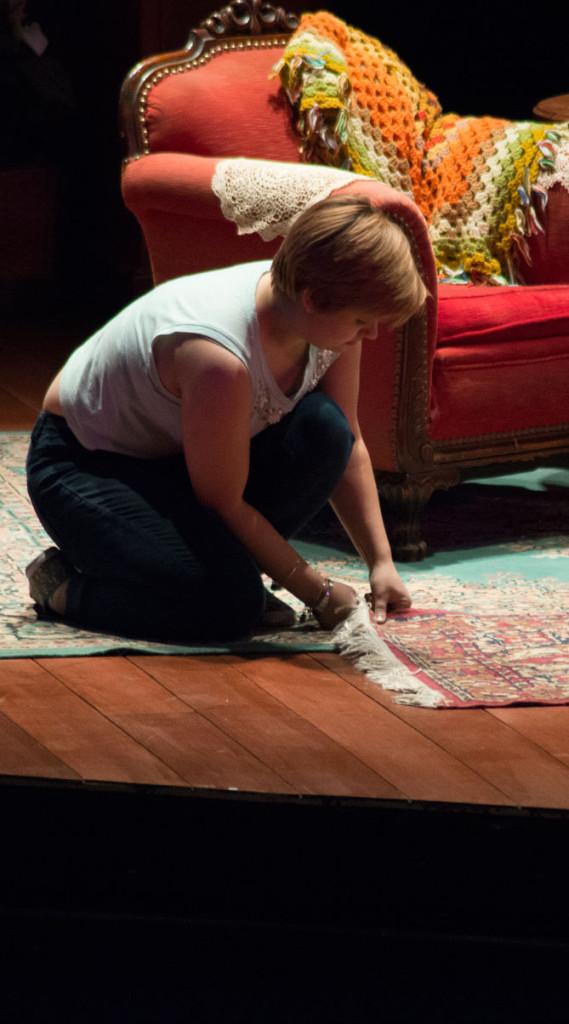
Adamson apologizes after nearly every instruction. She is well aware of her self-conscious leadership style, which stems from her having been the one on top of the ladder.
“A couple of years ago I was the props master for a show that had a lot of paintings on the wall and a lot of set dressing, so I kind of had to go through the same thing,” she said. “I was just like, ‘Oh my gosh, I’m putting you through the same thing I had to go through,’ and I felt so bad.”
Growing up in a family that centered around sports — with a father that wanted her to get a softball scholarship after she started switch-hitting at age 7 — Adamson is no stranger to performing under pressure, and that’s what she does now. The paintings slowly, but surely, go up on the walls.
Adamson controls it all from a small table at centerstage, her MacBook laptop, displaying her set design layouts, resting on the table. She half sits on the plastic chair, leaning sideways because she knows she will have to jump up again at a moment’s notice. Always high-energy, she is constantly moving — even bouncing nervously when she is sitting on the chair — constantly thinking, fluctuating between the table and helping her crew with painting placement. She often plays with the long, black shawl that is wrapped around her shoulders. When she’s not doing that, she’ll run her hands through her blond, pixie-cut hair. Anything to stay moving.
Tech rehearsals — the last step in the production process of “You Can’t Take it With You,” before opening night — begin tonight. They are when all of Blitz’s lighting, all of the costumes, all of Adamson’s set, will finally come together to create a cohesive production. Adamson watches with pride as her little black box, her vision for the set, slowly becomes a reality.
“I’m constantly thinking, ‘What goes next?’” she says. “I kind of have a half plan, but at this point, I’m just going with the flow.”
Creating Fluidity:
There is a nervous energy, almost an electricity, that surrounds the first night of tech rehearsal. There is just one week left until opening night. Months of work, planning and practicing have come down to these final seven days.
Crew members are spread among the rows of maroon, plush chairs in Hoerner and are talking among one another, trying to keep the mood light, but the exhaustion and stress that lingers in the air is almost palpable. It is 10 p.m., and the crew has already been at it for three hours, running through the same scenes over and over, perfecting lighting, cues and props.
Senior Kelly Frisch sits in the center of the theater, about 10 rows back from the stage. As the show’s stage manager, tech rehearsals are the beginning of what will be her busiest time during the production process. Later, when the show opens, she will move up to the tiny, cramped booth above the audience in the back of the theater, but for now, she’s at the center of the action. Her short, brown hair is pulled back loosely into a ponytail, and a headset, which she uses to communicate with the rest of the production crew, frames her face.
Her entire life, Frisch has been told she is too small. Too small for her school’s volleyball team. Too small even to be part of the set team in her middle school play because she wasn’t big enough to move any of the pieces. So they made her assistant stage manager, and it made her feel big.
A decade later, Frisch has pursued her passion for entertainment management — recently signing a contract with Disney World to work in its theaters, festivals and parades upon graduation in May. It is her job to call the entire play. As the stage manager, she is the self-described “mom” of the production. Not only does she make sure each person in the cast and crew is in the right place at the right time, but she also works to keep morale high, especially on long nights like this one.
“I make it happen, and I make everyone feel positive and happy about what they’re doing,” she said. “We all get stressed out. And it starts to get hard once it gets down to the nitty-gritty, or if we are running it so much, we’re so exhausted. It’s just our job to make sure energy’s up.”
Sitting in the darkened theater — the only lighting is that on the stage, Blitz’s work coming to life — Frisch controls the entire production. A soft “go” into her headset can cue a lighting change, an actor’s entrance, the curtain falling.
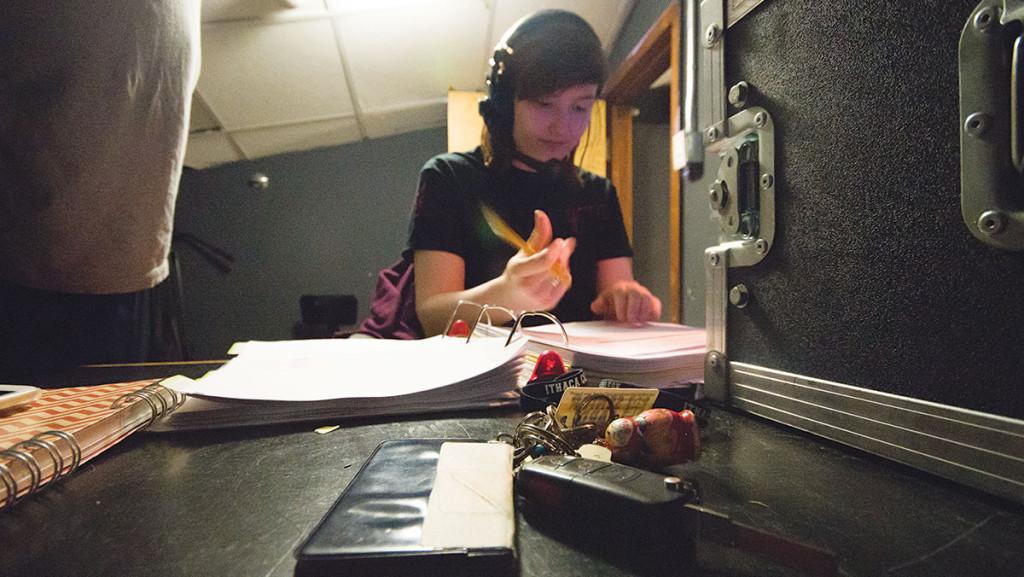
As she directs, Frisch is wracked with nerves. It is a learn-by-doing process, and she knows any mistake she makes will be obvious to the audience. Though it is not her first time stage managing at the college — she was also stage manager for “The Good Person of Setzuan” in Fall 2014 — she can’t shake the nerves that come with a new production.
She jokingly dances in her seat, making eye contact and smiling with several other crew members. Keeping the energy high is her way of masking exhaustion, which lies folded in her more subtle movements. Everyone is tired today, though it is just the first day in a weeklong series of tech rehearsals.
Frisch often pauses the play to make corrections, her voice amplified throughout the theater as she directs the cast and crew:
“We’re going to start with Grandpa’s line. Whenever you’re ready.”
And so it goes. Every stoppage, every start, is under Frisch’s direction. The four-hour tech rehearsal is long for the crew members, who all jot notes down as they go, improvements they need to make before opening night, which is just a short week away. It’s a game of perfection for them, trying to fit each piece of the puzzle just so.
Some pieces don’t quite fit just yet, though. Actors occasionally trip over the layered rugs on the stage, and some of the lighting cues are off. The crew works tirelessly to fix these mishaps, but it’s not without struggle, as it often takes five or six run-throughs of the exact same act, scene, moment to make any improvements at all.
While Frisch is controlling the onstage action, Blitz is seated off to her left, two large monitors showing lighting grids — similar to those he sketched on wax paper just weeks before — in front of him. He and Frisch are in constant communication, trading notes about lighting cues. But then again, Frisch is in communication with just about everyone, and when she’s talking to others, Blitz keeps quietly to himself, idly sketching on a gridded notebook, gray beanie pulled over his cropped hair and red-checkered flannel shirt stretching over his shoulders.
Blitz comes from an artistic background — his father graduated from the Pratt Institute and his mother is a high school art teacher. When he entered the college in Fall 2010 as a business major, he quickly realized that he needed to return to the creative side of the entertainment industry.
“I was more in the paperwork side of it,” he later said. “I definitely wanted something more artistically focused, something more hands-on with the design process.”
It was his freelance photography work that sparked his fascination with lighting design.
“Lighting seemed to be the most logical jump as far as taking what skills I had to a different set of circumstances,” he said.
After taking the 2013–14 academic year off, Blitz is set to graduate with the Class of 2015. But not before “You Can’t Take it With You” is complete. It is his first main stage lighting design at the college, and Blitz takes it incredibly seriously, watching intensely as tech rehearsal continues.
He is looking for two main lighting issues: color and timing. Some of the lighting cues he drew up while reading the script and watching rehearsals are slightly off, and he notes these to fix later. As for the lights’ color, he controls the hue and intensity of each lighting change, and has labored for months to pick exactly the right shades.
“What I really like about it is that it’s sort of free space,” he says. “Obviously, you still have to fit it into the framework of a show, but for the most part it’s the one thing that you can get away with whatever idea you want, really drive movement. You can play with mood, you can play with emotion. Sure, you can build a set that has life and this certainly has character and has something to it that says what it is about the family that lives here. But it’s not something that changes with every mood that the performers are feeling.”
The tech rehearsal wraps up at 11 p.m. sharp. After a brief meeting in which the production team shares notes and suggests improvements — everyone has notes for not only themselves, but also the rest of the crew — they are finally done for the night. They will meet again as a group tomorrow night, then will partake in what they call a “10 out of 12” on Sunday, which means they work for 10 of 12 hours. Beginning at 11 a.m. Monday will be the group’s dress rehearsal before preview on Tuesday.
“What I really like about it is that it’s sort of free space. Obviously, you still have to fit it into the framework of a show, but for the most part it’s the one thing that you can get away with whatever idea you want, really drive movement.” [citation] — Zac Blitz [/citation]
“It’s a really cool process,” Frisch said afterward. “It’s also really long and tedious but a lot of fun. It’s when you start seeing it come to life. You’re very tired at the end.”
Dressing it up:
The dress rehearsal, the team’s final practice run before preview, arrives quicker than anyone thought it would. There isn’t much — if any — time left to tinker with the set, or the lighting or the cues. This rehearsal has to go smoothly. Frisch, in particular, feels pressured as around 30 audience members file into the theater and scatter among the seats up front, close to the stage, to watch this final practice run.
“I thought this show was going to be a lot easier than it was,” Frisch said. “It was a really exciting process, but it was really nerve-wracking for me, just making sure that I’m giving the life that the show needs. I was so nervous [on Monday night.]”
Finally in her booth above the theater, Frisch’s equipment has been relocated with her. She calls the play through a small window that overlooks the stage. She no longer has the cushion of being able to stop and start the play at her leisure. Everything must be fluid tonight. To her immense relief, the first half of the show runs smoothly.
At intermission, Frisch heads nervously down to the bathroom to listen to the audience’s reactions — a tradition she undertakes during every show in which she is involved.
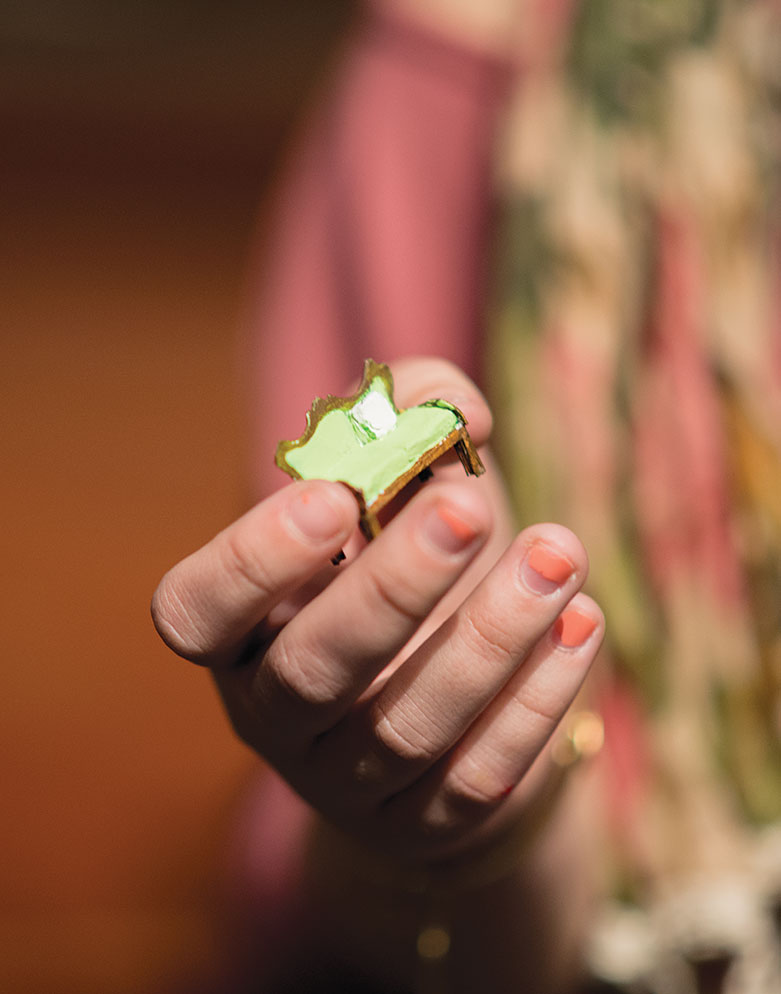
“We heard very good things in the bathroom on Monday,” she said later, laughing. “It’s a good feeling.”
Meanwhile, Adamson is watching the play from her normal spot, off to the right of the theater. Where her set still needed tinkering during tech rehearsals, it is now finally complete, and she looks on it with pride. Though she still types notes throughout the show, they are smaller fixes rather than large problems: “close the basement door!!!,” “fix chandelier plate things,” “make snakes more visible?”
Her excitement is evident throughout the opening scenes. When the audience laughs, she laughs, but it is a satisfied laughter. She has seen the scenes too many times to be surprised by any of the jokes. Nevertheless, she’s proud of them. She’s laughing more at the audience’s reactions. They bring her joy. It’s her favorite moment, this accumulation of her hard work.
“When the curtain goes up, and you’re just looking at it and you start to see the audience reacting to things … ” she says, trailing off. “Having people who may not be involved as much and seeing it for the first time — it’s really nice to hear their reactions.”
The show ends, and the curtains close for the final time that night. The next time they open, it will be for preview, the first show in front of a full audience. Most of their work done, Blitz and Adamson can finally relax a bit, their process slowing down considerably after dress rehearsal — though not too much, as they will continue to monitor their respective designs throughout the performances.
Frisch, on the other hand, still has work to do. The second preview begins, the show is essentially handed from the director, who is more involved during the tech rehearsal process, down to her. But she doesn’t see it as more work. For her, it’s a time to shine, a time to proudly display her team’s work to the world.
“I think my favorite part is the moment that the show gets handed over to me, and I get to show off everything that everyone has been working for because my team is the only one besides the actors that go through the process together,” she said. “So it’s really exciting to see people see the art that we have made.”
After the show ends:
Like every other show he has been a part of, Blitz’s favorite part of the show is after the curtain has closed. It is then that the cast and crew return to the stage to recreate moments — if only briefly — and photograph them for the show’s photo call.
It is this moment that Blitz cherishes most. Later, once the set is taken down, the chaos of the production process complete, the stage once again becoming a giant, black, blank canvas, Blitz will still have his photos: 8 1/2 x 11 sheets that are his evidence of what he and the rest of the team have created. They are tangible proof that the shows — something so temporary — have existed in his life.
This reflection is something Blitz never has a chance to do throughout the process — the long nights spent staring at color swatches, which, in the blink of an eye transitioned to the long nights taking notes during technical rehearsals that transitioned, just as quickly, to the long nights making sure everything ran just so during the show — it is this that will cause the nostalgia. Because by the time Blitz holds the glossy, still photograph in his hands, the show will have already ended.
Blitz has shown these photos to people who later ask about his plays: those who do not get to see the production live. It is his way of holding onto something that was such a momentous part of his life. His own keepsake.
“You take a photo of a moment, and you just think of all of the good things about the show,” he said. “You can bring that photo to everybody and say, ‘This is what I did.’ If you have the whole set and you have the lighting work and you have everybody in their costumes, you can just look at that 8 1/2 x 11 picture, that full page and just say, ‘Man, it’s been a great show.’”


